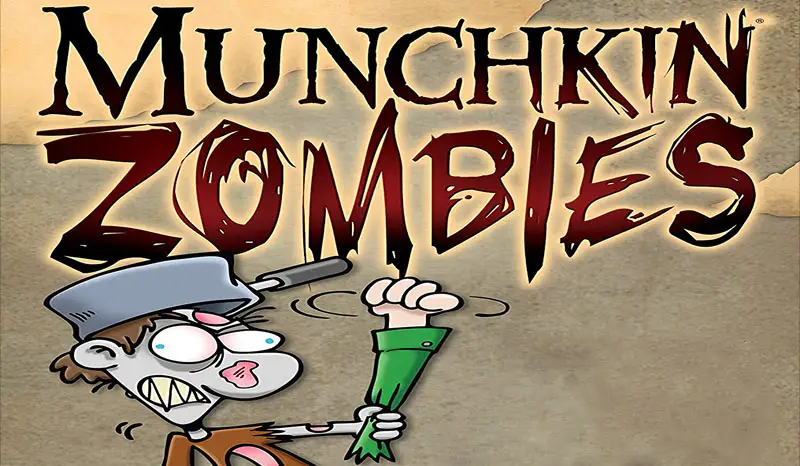
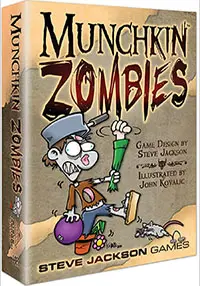
The munchkins are dead, but that won't stop them! They're zombies, and they go up levels by eating tasty BRAAAIINNNS!
Munchkin Zombies is based on the original Munchkin and can be combined with it or with any other Munchkin set (see the last page).
The foes in this game are mostly normal people just trying not to get eaten, but the rules still refer to "monsters", for consistency with earlier games. You're zombies. You don't know any better.
The foes that are not normal people are rogue zombies. They're just as tasty as everyone else.
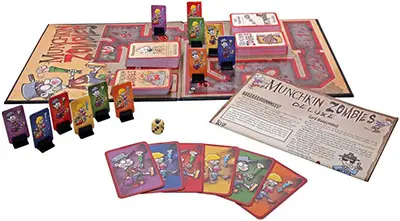
Compoments
- 168 cards
- one six-sided die
- Rulebook
Setup
Three to six can play. You will need 10 tokens (coins, poker chips, whatever - or any gadget that counts to 10) for each player.
Divide the cards into the Door deck and the Treasure deck. Shuffle both decks. Deal four cards from each deck to each player.
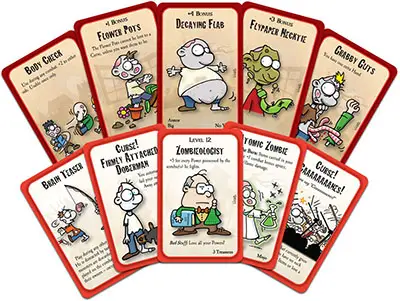
Card Management
Keep separate face-up discard piles for the two decks. You may not look through the discards unless you play a card that allows you to!
When a deck runs out, reshuffle its discards. If a deck runs out and there are no discards, nobody can draw any of that kind of card!
In Play
These are the cards on the table in front of you, showing your Mojo and Powers (if any) and the Items you are carry- ing. Continuing Curses and some other cards also stay on the table after you play them.
Your Hand
Cards in your hand are not in play. They don't help you, but they can't be taken away except by cards that specifically affect "your hand". At the end of your turn, you may have no more than five cards in your hand.
When Cards Can Be Played: Each type of card can be played at a specified time (see p. 5).
Cards in play may not be returned to your hand - they must be discarded or traded if you want to get rid of them.
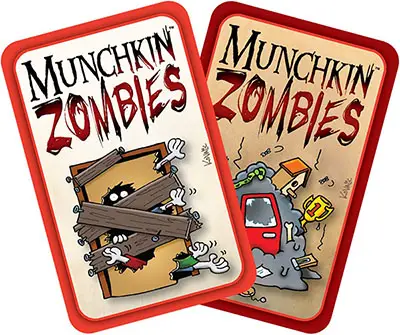
Character Creation
Everyone starts as a Level 1 zombie with no mojo. (This is a zombie movie, so no one has any class).
Look at your initial eight cards. If you have any Mojo cards, you may (if you like) play one by placing it in front of you. If you have any usable Items (p. 5), you may play them by placing them in front of you.
If you have any doubt about whether you should play a card, you could read below, or you could just charge ahead and do it.
Starting and Finishing the Game
Decide who goes first in any agreeable manner. Heh, heh.
Play proceeds in turns, each with several phases (see below). When the first player finishes his turn, the player to his left takes a turn, and so on.
The first player to reach 10th level wins . . . but you must reach 10th level by killing a monster, unless a card specifically allows you to win another way.
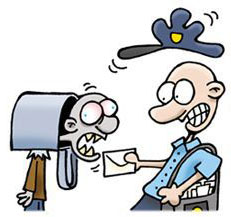
Turn Phases

At the start of your turn, you may play cards, switch items from "in use" to "carried" or vice versa, trade items with other players, and sell items
for levels. When your cards are arranged the way you want, go to phase 1.
-
Kick Open The Door: Draw one card from the Door deck and turn it face up.
If it's a monster, you must fight it. See Combat. Resolve the combat completely before you go on. If you kill it, go up a level (or two, for some especially nasty monsters!) and take the appropriate number of Treasures.
If the card is a Curse - see Curses - it applies to you immediately (if it can) and is discarded.
If you draw any other card, you may either put it in your hand or play it immediately.
-
Look For Trouble: If you did NOT draw a monster when you first opened the door, you now have the option of playing a monster (if you have one) from your hand and fighting it, just as if you had found it when you kicked open the door.
Don't play a monster you can't handle, unless you're sure you can count on getting help!
-
Loot The Room: If you did not find a monster by kicking open the door and you did not Look For Trouble, you loot the room . . . draw a second card from the Door deck, face down, and place it in your hand.
If you met a monster but ran away, you don't get to loot the room.
-
Charity: If you have more than five cards in your hand, you must play enough of them to get down to five, or give the excess to the player with the lowest Level.
If players are tied for lowest, divide the cards as evenly as possible, but it's up to you who gets the bigger set(s) of leftovers. If YOU are the lowest or tied for lowest, just discard the excess.
It is now the next player's turn.
Combat
To fight a monster, compare its combat strength to yours. Combat strength is the total of Level plus all modifiers - positive or negative - given by items and other cards.
If the monster's combat strength is equal to yours, or greater, you lose the combat and must Run Away - see below. If your combat strength totals more than the monster's, you kill itand go up a level (two for some big monsters). You'll also get the number of Treasures shown on its card.
Sometimes a card will let you get rid of the monster without killing it. This is still "winning", but you don't get a level.
Sometimes, depending on the card, you might not get the treasure, either. Some monster cards have special powers that affect combat - a bonus against one Mojo or Power, for instance. Be sure to check these.
One-shot cards (the ones that say "Usable once only") may be played directly from your hand during combat. You can also use one-shot Items that you already had in play. Discard these cards after the combat, whether you win or lose.
Some Door cards may also be played into a combat, such as monster enhancers.
While you are in combat, you cannot sell, steal, equip, unequip, or trade items, or play Items (except for one-shots) from your hand. Once you expose a monster card, you must resolve the fight with your equipment as it stands, plus any one-shot items you choose to play.
Discard the monster card, including any enhancers and one-shot cards played, and draw treasure (see below). But note: some- one may play a hostile card on you, or use a special power, just as you think you have won.
When you kill a monster, you must wait a reasonable time, defined as about 2.6 seconds, for anyone else to speak up. After that, you have really killed the monster, and you really get the level(s) and treasure, though they can still whine and argue.
Fighting Multiple Monsters
Some cards (notably Wandering Monsters) allow your rivals to send other monsters to join the fight. You must defeat their combined combat strengths. Any special abilities, such as fighting with your Level only, apply to the entire fight.
If you have the right cards, you can eliminate one monster from the combat and fight the other(s) normally, but you cannot choose to fight one and run from the other(s). If you eliminate one with a card, but then run from the other(s), you don't get any Treasure!
Asking for Help
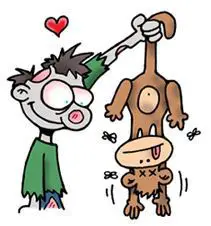
If you cannot win a combat on your own, you may ask any other player to help you. If he refuses, you may ask another player, and so on, until they all turn you down or someone helps.
Only one player can help you, adding his combat strength to yours. Anyone can play cards to affect your combat, however!
You can bribe someone to help. In fact, you'll probably have to. You may offer your helper any Item(s) you are currently carrying, or any number of the Treasure cards the monster has.
If you offer him part of the monster's treasure, you must agree whether he picks first, or you pick first, or whatever.
The special abilities or vulnerabilities of the monster also apply to your helper, and vice versa. For instance, if you are not a Voodoo Zombie yourself, and a Voodoo Zombie helps you against the Nun, the monster is -2 against you. But if you are facing the Tax Man and a Voodoo Zombie helps you, the monster's combat strength is increased by 5.
If someone successfully helps you, the monster is slain. Discard it, draw treasure (see below), and follow any special instructions on the monster card. You go up a level for each slain monster. Your helper does not go up. You draw the Treasure cards, even if it was your helper's special ability that defeated the monster.
Interfering with Combat
You can interfere with others' combats in several ways:
Use a one-shot card. You could help another player by throwing a one-shot at his foe. Of course, you can "accidentally" hit your friend with the card, and it will count against him.
Play a card to modify a monster. These cards (usually) make a monster stronger . . . and give it more treasure. You can play these either during your own combats or during someone else's combat.
Play a Wandering Monster along with a monster from your hand to join any combat.
Curse them, if you have a Curse card.
Running Away

If nobody will help you . . . or if somebody tries to help, and your fellow party members interfere so the two of you still cannot defeat it . . . you must ' run away.
If you run away, you don't get any levels or treasure. You don't even get to Loot the Room. And you don't always escape unharmed . ..
Roll the die. You only escape on a 5 or better. Some Items or abilities make it easier or harder to run away. And some monsters are fast or slow, and give you a penalty or bonus to your roll.
If you escape, discard the monster. You get no treasure. There are usually no bad effects . . . but read the card. Some monsters hurt you even if you get away from them!
If the monster catches you, it does Bad Stuff to you, as described on its card. This may vary from losing an item, to losing one or more levels, to Death.
If two players are cooperating and still can't defeat the monster(s), they must both flee. They roll separately. The monster(s) CAN catch them both.
If you are fleeing from multiple monsters, you roll separately to escape each one, in any order you choose, and suffer Bad Stuff from each one that catches you as soon as it catches you.
Discard the monster(s).
Death
If you die, you lose all your stuff. You keep your Mojo(s), your Power(s), and your Level (and any Curses that were affecting you when you died). If you have Double Mojo, keep that as well. Your new character will look just like your old one.
Looting The Body: Lay out your hand beside the cards you had in play. Starting with the one with the highest Level, each other player chooses one card . . . in case of ties in level, roll a die. If your corpse runs out of cards, tough. After everyone gets one card, the rest are discarded.
Dead characters cannot receive cards for any reason, not even Charity, and cannot level up.
When the next player begins his turn, your new character appears and can help others in combat . . . but you have no cards.
On your next turn, start by drawing four cards from each deck, face-down, and playing any legal Mojo, Power, or Item cards you want to, just as when you started the game. Then take your turn normally.
Treasure
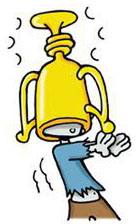
When you defeat a monster, either by killing it or using a card to eliminate it, you get its Treasure. Each monster has a Treasure number on the bottom of its card.
Draw that many treasures. Draw face- down if you killed the monster alone. Draw face-up, so the whole party can see what you got, if someone helped you.
Treasure cards can be played as soon as you get them. Item cards can be placed in front of you. "Go Up a Level" cards can be used instantly. You may play a "Go Up a Level" card on any player at any time.
Character Stats
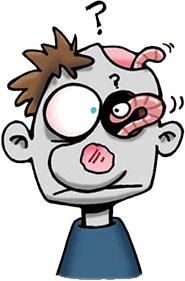
Each character is basically a collection of weapons, armor, and magic items, with three stats: Level, Mojo, and Powers. For instance, you might describe your character as "a 9th-level Fast Stealthy Atomic Zombie with Glowing Talons and a Shopping Cart".
Level: This is a measure of how generally buff and studly you are. When the rules or cards refer to your Level, capitalized, they mean this number.
You gain a level when you kill a monster, or when a card says that you do. You can also sell items to buy levels (see Items).
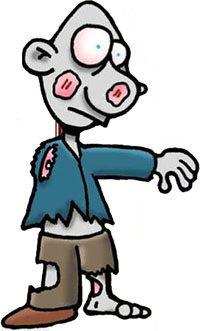
You lose a level when a card says that you do. Your Level can never go below 1. However, your combat strength can be negative, if you get hit with a Curse or have some other kind of penalty.
Mojo
Your "Mojo" is the source of your special zombie abilities. Characters may be Atomic, Plague, or Voodoo Zombies. If you have no Mojo card in front of you, you are just a boring ordinary zombie.
Each Mojo has different abilities, shown on the cards. You gain the abilities of a Mojo the moment you play its card in front of you, and lose them as soon as you discard that card. Some Mojo abilities are powered by discards. You may discard any card, in play or in your hand, to power a special ability. See the Mojo cards for when abilities can be used.
You can discard a Mojo card at any time, even in combat: "I don't wanna be a Plague Zombie anymore". When you discard a Mojo card, you become just a plain zombie until you play another Mojo card.
You may not belong to more than one Mojo at once unless you play the Double Mojo card. You may not have two copies of the same Mojo card in play.
Powers
There are six of these horrible undead abilities (and 15 cards, because each one appears multiple times). You gain the advan- tages the moment you play its card in front of you, and lose them as soon as you lose or discard that card.
Each Power in Munchkin Zombies has a Rank of 2, 3, or 4. You may have any number of Powers as long as their total Rank does not exceed your Level. There are no Rank 1 Powers in this game, so starting zombies can have no Powers.
Powers are treated like Mojos. You can't trade them to other players, but you may play a Power from your hand at any time you can legally use it. You may not play Powers that you cannot legally use. But you may discard Powers at any time and replace them with Powers from your hand.
If your Level goes down to less than the total Rank of your Powers, you must discard some Powers so that their total Rank is once again less than or equal to your Level.
Duplicate Power cards give no extra effect. When you die, you keep all the Powers you have in play, just as you keep your Mojo. Some Powers may require discards to use. You may discard any card, in play or in your hand, to power a Power.
Items

Each Item card has a name, a size, and a value in Gold Pieces. Each Item is also good for something. It may give you a combat bonus, or a special ability, or both.
An Item card in your hand does not count until you play it; at that point, it is "carried". You may carry any number of small Items, but only one Big one. (Any item not designated Big is considered small).
If something lets you have more than one Big item (for instance, the StrongPower) and you lose that ability, you must either correct the problem immediately or get rid of all but one Big item.
If it's your turn and you're not in combat, you can sell the excess Big items (as long as you have at least 1,000 Gold Pieces of Items to sell). Other- wise, you must give them to the lowest-Level player(s) who can carry them! If any Big items are still left over, discard them
Likewise, you may also use only one headgear, one suit of armor, one pair of footgear, and two "1 Hand" items (or one "2 Hands" item) . . . unless you have a card tha lets you ignore these limits. If you are carrying two Headgear cards, for instance, only one of them can help you.

You should indicate Items that can't help you, or extras not being worn, by turning the cards sideways. You may NOT change your used and carried Items during a combat or while running away.
You cannot discard Item cards "just because". You may sell Items for a level, or give an item to another player who wants it. You may discard to power certain Mojo abilities and Powers. And a Curse may force you to get rid of something!
Trading: You may trade Items (but not other cards) with other play- ers. You may only trade Items from the table - not from your hand. You may trade at any time except when you're in combat - in fact, the best time to trade is when it's not your turn. Any Item you receive in a trade must go into play; you can't sell it until it's your turn.
You may also give items away without a trade, to bribe other players - "I'll give you my Arm and a Leg if you won't help Bob fight the Action Hero!" You may show your hand to others. Like we could stop you.
Selling Items for Levels: During your turn, you may discard Items worth at least 1,000 Gold Pieces and immediately go up one level. If you discard (for instance) 1,100 Gold Pieces worth, you don't get change. But if you can manage 2,000 worth, you can go up two
levels at once, and so on. You may sell items from your hand as well as those you are carrying. You may not sell items to go to Level 10.
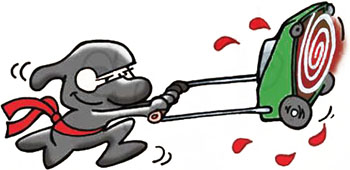
Monsters
If drawn face-up during the "Kick Open The Door" phase, they immediately attack the person who drew them.
If acquired any other way, they go into your hand and may be played during "Looking For Trouble", or played on another player with the Wandering Monstercard.
Each Monster card is a single monster, even if the name on the card is plural.
Hordes of Zombies
Several monsters in this set are rogue zombies. They are all tagged Undead.You may play any Undead monster from your hand into com- bat to help any other Undead, without using a Wandering Monster card. If you have a card that can be used to make a monster Undead, you may play it with a non-Undead monster to use this rule.
If you're blending Munchkin Zombies with other Munchkin sets, the Undead from those sets can join the horde, too! (Clerics from the original Munchkin get bonuses against all Undead monsters, even if those Clerics are zombies themselves).
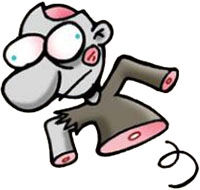
Monster Enhancers
Certain cards, called monster enhancers, raise or lower the combat strength of individual monsters. (Yes, you can have a negative enhancement).Monster enhancers may be played by any player during any combat.
All enhancers on a single monster add together. If there are multi- ple monsters in a combat, the person who plays each enhancer must choose which monster it applies to.
Items - Playing Them
Any Item card may be played to the table as soon as you get it, or at any time on your own turn other than in combat (unless the card itself says otherwise).
Items - Using Them
Any one-shot Item can be played during any combat, have it in your hand or on the table. (Some one-shot Items, such as the Wishing Ring, may also be used outside of combat).
Other items stay on the table in front of you once they are played. You may keep Items in front of you that you cannot legally use (be- cause of your Mojo, Powers, or because you're already using other Items of that type).
Turn these Items sideways. These Items are "carried" but not "in use". Exception: You may have only one Big item in play at a time unless you have a Power or a card that will let you use more.
You get no benefits from Items turned sideways.
Other Treasures
Other Treasure cards (like Go Up a Level cards) are "specials". You may play these at any time, unless the card itself says otherwise. Fol- low the card's instructions, then discard it, unless it has a persistent bonus like an Item.
Curses
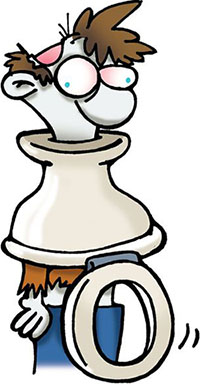
If drawn face-up, during the "Kick Open TheDoor" phase, Curse cards apply to the person who drew them.
If drawn face-down or acquired some other way, Curse cards may be played on ANY player at ANY time. Anytime, do you hear me? Reducing someone's abilities just as he thinks he has killed a monster is a lot of fun.
Usually, a Curse affects its victim immediately (if it can) and is discarded. However, some Curses give a penalty later in the game or have a continuing effect. Keep these cards until you get rid of the Curse or the penalty takes effect.
If someone plays a "your next com- bat" Curse on you while you are in combat, it counts in that combat! (Curse cards you keep as a reminder may not be discarded to use Mojo abilities or Powers. Nice try!)
If a Curse can apply to more than one Item, the victim decides which Item is lost or Cursed.
If a Curse applies to something you don't have, ignore it. For instance, Bass Ackwardsmakes you lose the armor you are wearing. If you have no armor, nothing happens; discard the card.
Continue Reading


